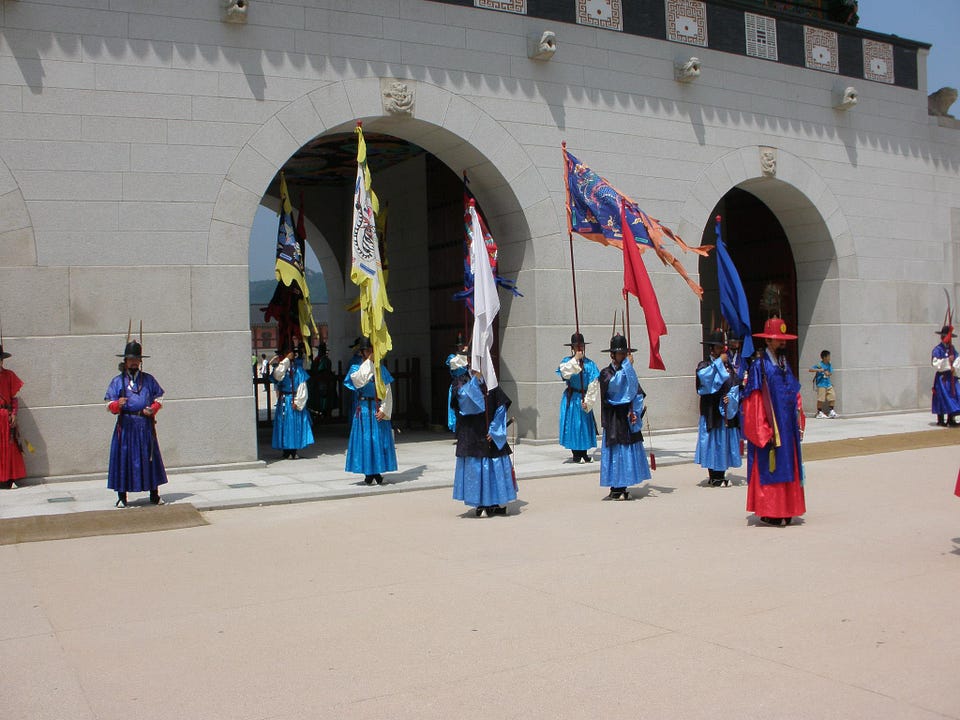Open Air Museum «A Palace of Shining Happiness»
South Korea is a country and museum at the same time. Here you can walk along the streets and enjoy unusual constructions, buildings and green parks. You can enjoy modern constructions and historical places located close to each other.
South Korea has enormous an cultural and historical heritage. Unfortunately, not all these historical monuments could survived till today, and some of them were reconstructed or restored recently. But, many historical places were rearranged to the museums, so people can visit it and learn about Korea more. In this post I will introduce to you one of the oldest historical heritage — Gyeongbokgung Palace (경복궁).
Many people call this palace ‘Gyeongbokgung’, however, it is not so correct lingustically. The ending ‘gung’ (궁) means ‘palace’ from Korean languge. Therefore, the right interpretation of Gyeongbokgung is Gyeongbok Palace. The name of the palace has a several meanings. A palace of shining happiness, A palace of sun light and happiness…
The palace was built in 1395, during the Joseon Dynasty. And it is one of the largest and historically important palaces of that dynasty.
During the Joseon Dynasty 5 royal palaces were built (Gyeongbokgung Palace, Gyeonghuigung Palace, Changdeokgung Palace, Changgyonggung Palace, Doksugung Palace). All of them are located in Seoul. Initially, all of them were connected, but today all of them are separated.
To the North from the Gyeongbokgung Palace stand huge North Mountains, and to the South from the palace — Gwanhwamun Square.
 |
| Palace map |
 |
| Royal guards |
 |
| Main gates — Kwanghwamun gates |
 |
| Guard’s change ceremony |



A only king could enter the palace through the main gates. The western and eastern gates were used by high-positioned official and aristoracy. The North gates were for serving personal. Today there is a president residence or Blue house (Chonwadae) behind the palace.
The entrance to the palace is not free. The adult ticket costs 3 dollars, and ticket for children costs 1,5 dollars. But if you wear korean traditional dress (hanbok), you can enter the palace for free. Every Tuesday palace doesn’t operate.
Gyeongbokgung Palace was almost absolutely destroyed during the Imjin War, Japannese invasion of Korea. During the war king and a royal family should have leave a Gyeongbokgung Palace, and they moved to another palace — Doksugung Palace. So Gyeongbokgung Palace was empty for about 3 centures. And only during King Kojeong’s government Gyeongbokgung Palace was restored and became a royal family’s residence again.
Imjin War (1592–1598) — Japannese invasion of Korea. This war left a huge mark in Korean history. This war destroyed a plenty of beautiful historical and cultural places. Also, it took away many lifes.
However, in 1911 Japannese army landed to Korean peninsula again and Gyeongbokgung Palace got injured again. Almost all constructions were destroyed, and only 330 were saved.
Now, let’s enter the palace and look inside it. Let’s look at the construction which were saved till today.
This palace is always crowded. Mostly, these are tourists. Because Gyeongbokgung Palace is number 1 in the lists of top sights of Seoul.
 |
| The gates which lead to the Throne Hall |
Along the stone track we will go to the heart of the Palace — to the Throne Hall. As you can see this stone way is divided into 3 lines. Do you know why? The middle part is the widest one, and it was used only by the King. The side two paths were used by others. Along the path you can see small pillars with some wrtitings. These pillars mean the rank of the officials, as higher rank, as closer official could come to the throne hall, i.e. to the king, during the appointment.
 |
| This is a path to the Throne Hall (the 3rd path is almost invisible on this photo) |
And here it is, a Throne Hall, and Throne itself. The msot important and official ceremonies and appointments took a place here. On the top of the Throne hall you can see golden dragons, which was associated with a power and supreme authority. I will emphasize that it is an only golden thing in the Palace. This is one of the main specifics of the Joseon Dynasty, they didn’t use much gold in the Royal construction. Remember the Petergrof in Russia, which is shining of golden stuff. Joseon Dynasty kings thought that golden decoration is wasting of money, and instead of it, it is more useful to use these money on development of country.
 |
| Throne Hall |
On the building roof you can see small figures of animals. These animals were protecting the buildings from evil spirits. The number of figures shows the importance of the building, as many figures are there so more important the building.
 |
| Animal figures on the building roof |
 |
| Gyeonghoeru Pavilion |
 |
| Gyeonghoeru Pavilion |
 |
| Hyangwonjeong pavilion |
 |
| Palace at fall |
 |
| Throne hall with modern skyscrappers on the background |
Комментарии
Отправить комментарий